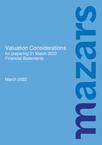
Technical Guidance | Valuation Considerations for preparing 31 March 2022 Financial Statements
Published Date: March 28, 2022
Technical Guidance
Valuation Considerations for preparing 31 March 2022 Financial Statements
The season for the financial reporting period ending on or after 31 March 2022 has begun and is destined to be challenging and requires careful consideration. The geopolitical tensions in Russia and Ukraine with various trade sanctions have created a vague gloomy economic outlook coupled with ongoing daily sky-high new COVID-19 cases, fueling a seesaw like equity and commodity prices. These events pose additional challenges for financial statements’ preparers in determining the carrying amounts of assets.
Note that IFRS13 denotes fair value as an orderly transaction between the market participants to sell an asset or pay to transfer a liability at the measurement date. The orderly transaction is not a forced transaction and allows for marketing activities to take place.
Let's takes Nickel, a commodity, as an example. Nickel is a critical ingredient for electronic vehicles. Nickel's price was trading below USD25,000 per tonne by early March 2022. Within a day, on 8 March 2022, Nickel's price soared to USD100,000 per tonne, forcing a shut down in Nickel's trading. A rare shutdown, coupled with a thin market player, may indicate that the Nickel market was not trading in an orderly transaction and outside the realm of regular expectations. In such an event, we view that adopting Level 1 inputs to determine fair value may not be realistic for financial reporting purposes.
Impairment Assessment of Financial Assets
Impairment assessment of financial assets would be a key consideration for financial reporting purposes. The credit risks have been growing since the beginning of the COVID-19 pandemic. The accountant should perform an impairment assessment on all financial assets, from trade receivables' doubtful debts to possible defaults in the sovereign bonds, using the expected credit loss model (ECL). A good starting point to measure the ECL for trade receivables is by looking at the provisioning metrics based on the historical data, adjusted to the known or knowable information as of the financial reporting date.
Income Approach
For fair value using the income approach, or impairment assessment of non-financial assets determined by using the value-in-use model, the accountants may need to consider the followings:
- Cash flows growth assumptions must incorporate the latest economic and industry outlook, adjusted to the expected inflations relevant to the assets. Most economists generally expect a lower worldwide output in 2022, with higher than previously expected inflations.
- The transportation costs may increase due to supply chain disruptions. We find Freightos Baltic Index, a global container price index, provides a realistic gauge of products' shipping costs.
- The material costs may increase due to the surge in commodity prices, e.g. the Brent Crude Oil has increased from around USD70 per barrel early this year to the current level, one of the highest over the past ten years.
- Investors' expectations of equity returns can increase tremendously upon major economies' actual and expected rate hikes.
- The movements of the cost of debt as it fluctuates in tandem with the risk-free rate.
Quality of Assets
There are ongoing sanctions on Russia, from Russia's commodities to Russia's central bank assets. Most Russian banks are being removed from SWIFT, the global payments platform. The ongoing sanctions raised doubts about the quality of assets, such as cash in Russian banks, if these qualify as liquid or restricted assets.
Discounts for Lack of Marketability
All the events above also may give rise to higher discounts for lack of marketability (DLOM) of certain assets. An asset subjected to sanctions has limited potential buyers, resulting in higher DLOM adjustments. A commodity market with a lack of market participants may warrant some forms of DLOM adjustments to the observed prices. The extreme volatility of the market may also signal higher DLOM adjustments.
Final Word: Avoid Double-counting
We hope the audience finds this guidance useful in valuation considerations for financial reporting purposes, including matching the corresponding discount rate with cash flow projections. Asset-related risk factors must be carefully incorporated into cash flows projection or discount rate, ensuring no double-counting risks in valuation or impairment assessment.

